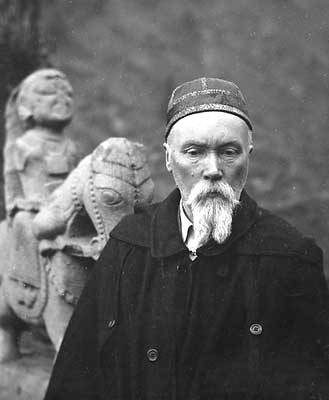Nicholas Roerich
By:
October 9, 2012

The 1913 premiere of Stravinsky’s Rite of Spring was a fiasco, and very nearly a riot, but it was also a detonation heralding a new age in the arts. Of everyone involved — including Diaghilev, Nijinsky, and Stravinsky — no one subsequently embarked on a stranger journey than the man responsible for the sets and costumes. Mystic, philosopher, explorer, and painter NICHOLAS ROERICH (1874–1947) was born into a wealthy St. Petersburg family; as a young man he became a leading expert on Russian folklore and folk arts, which led to his collaboration with the Ballets Russes. During WWI he retreated to an estate in Finland. With his wife, he immersed himself in Madame Blavatsky’s theosophy and the teachings of the Indian sages and began a lifelong attempt to reconcile all sacred teachings into a single religion. After the war he moved to America, where he opened the Master Institute of United Arts in Manhattan, which doubled as a museum and urban artists’ colony housed in a specially commissioned 27-story skyscraper on Riverside Drive (it’s still there, on 103rd Street — three bedroom apartments start at $1.7 million; H.P. Lovecraft was a frequent visitor; he called it one of his “shrines in the pest zone”). Soon after the institute was built, though, Roerich went on a multi-year trek across central Asia, before settling permanently with his family in Kullu Valley in the Himalayan foothills.

There he devoted himself to his art, filling thousands of canvases with his trademark glowing pinnacles, pagan stones and lonely lamaseries. Often corny, occasionally transporting, at their best Roerich’s paintings are portals to another world, a utopian wish concocted out of fragments of Medieval Russia, and an unearthly, mystical Tibet. For Lovecraft, they opened a door to other dimensions and alien orders of being. For Yuri Gagarin, they were a premonition of space. From his capsule he looked down to see Earth surrounded in “an indescribable gamut of colors! Just like the paintings of the artist Nicholas Roerich.”
***
On his or her birthday, HiLobrow irregularly pays tribute to one of our high-, low-, no-, or hilobrow heroes. Also born this date: Jacques Tati.
READ MORE about men and women born on the cusp between the Anarcho-Symbolist (1864–73) and Psychonaut (1874–1883) Generations.
